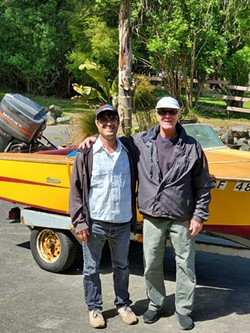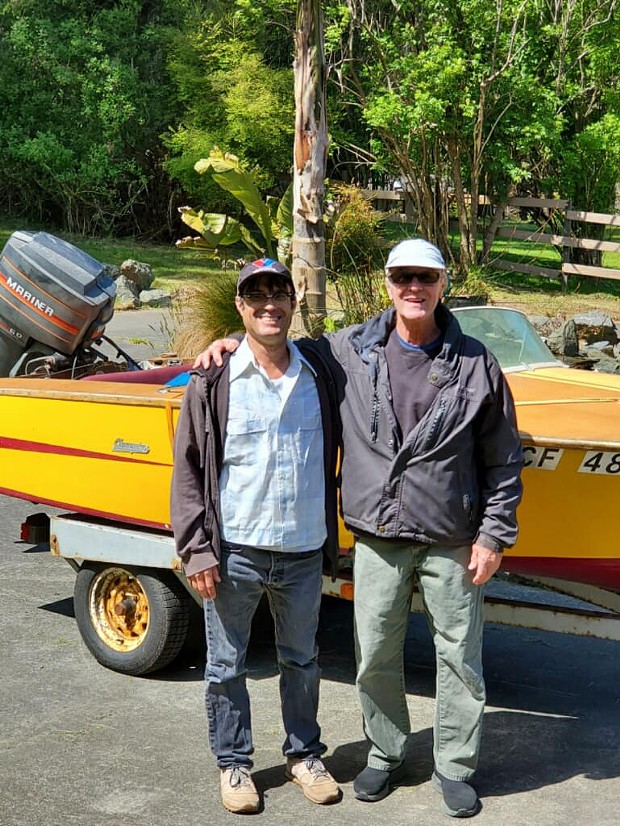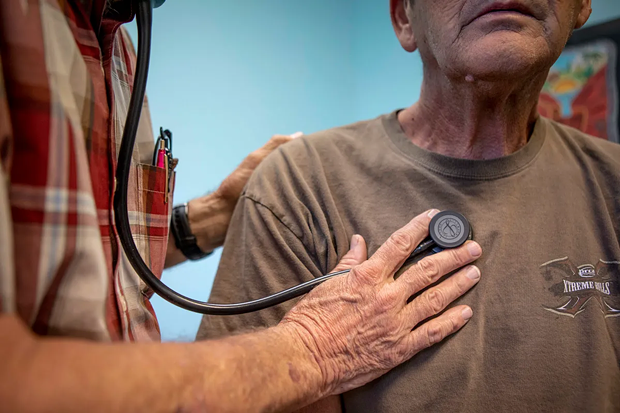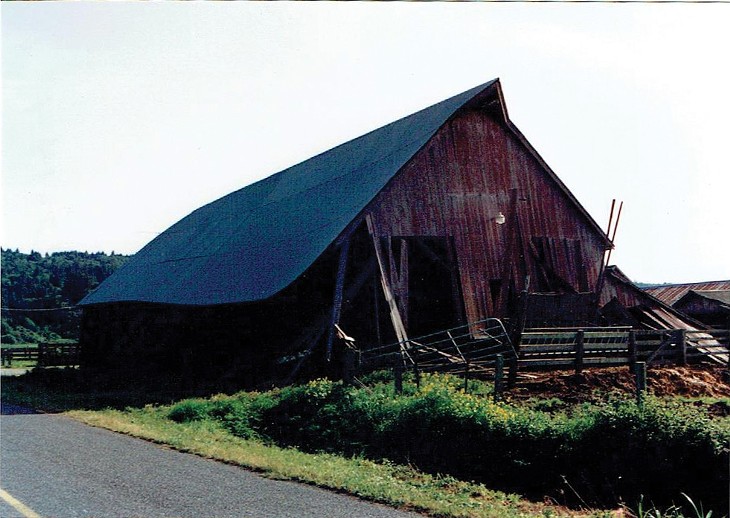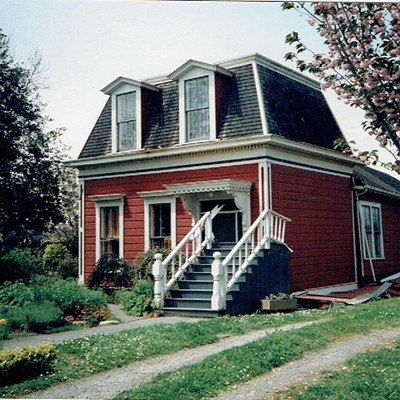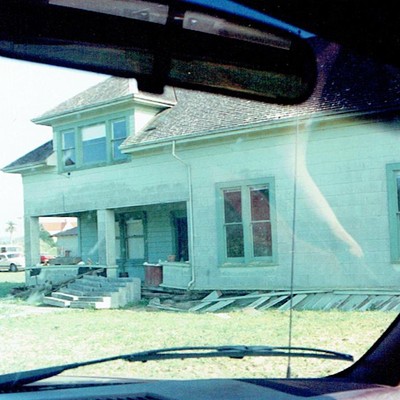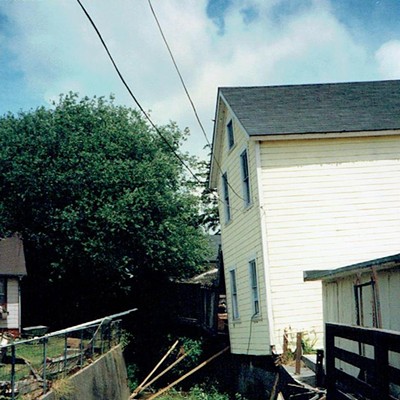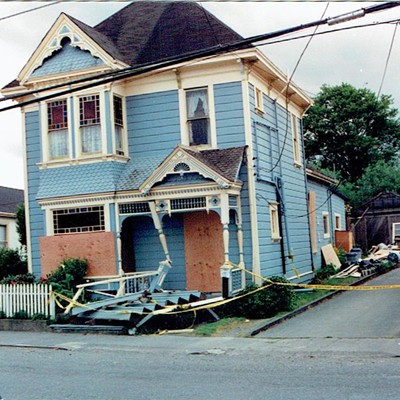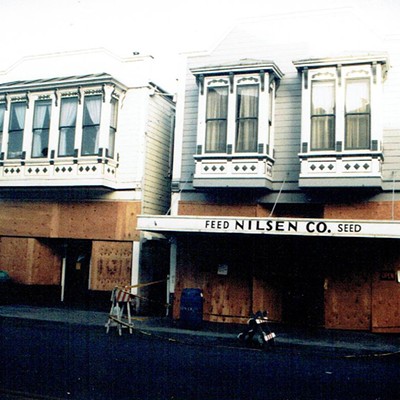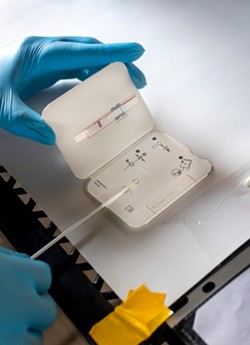Friday, April 29, 2022
Dive Team Set to Look For Missing Fishermen
Posted By Thadeus Greenson on Fri, Apr 29, 2022 at 4:08 PM
The team, working in conjunction with the Humboldt Bay Harbor, Recreation and Conservation District and California Fish and Wildlife, performed sonar scans earlier today and is currently preparing for a dive in the waters near where the men's boat was recovered Wednesday.
"We ask that community members avoid the area so that our crews can do their work," a press release states. "Even well-meaning self-initiated searchers can inadvertently have a negative effect on the search by reducing visibility and cluttering the waters. We will provide regular updates as they are available."
Scott Arbaugh and his son, Josh Arbaugh, both of Eureka, were reported missing after launching their 16-foot boat into Humboldt Bay to do some fishing. The boat was then found shortly after midnight, partially submerged, about a half-mile from King Salmon, with no sign of the men.
See the full release from Humboldt Bay Fire copied below.
The Humboldt Bay Fire Dive Rescue and Recovery Team along with the Humboldt Bay Harbor District and California Fish & Wildlife are currently continuing search efforts for the two men who went missing near King Salmon on Tuesday, April 26 based off of information received from the U.S. Coast Guard and Humboldt County Sheriff’s Office.
The team, along with Fish & Wildlife performed sonar scans earlier today and are currently preparing for a dive in the waters near where the boat was recovered mid-day on Wednesday, April 27.
We ask that community members avoid the area so that our crews can do their work. Even well-meaning selfinitiated searchers can inadvertently have a negative effect on the search by reducing visibility and cluttering the waters. We will provide regular updates as they are available.
Who’s Missing from California’s Community Colleges?
Posted By Emma Hall, Emily Forschen, Emily Margaretten and Oden Taylor/CalMatters on Fri, Apr 29, 2022 at 3:49 PM
“This raises critical concerns about equitable access to higher education as well as the ability to meet workforce needs,” said Paul Feist, vice chancellor of communications for the California Community College Chancellor’s Office. “It is why the entire community college system has mobilized to stabilize and turn back these declines.”
California lawmakers last year gave the system $120 million to help bring students back. So far, as CalMatters has previously reported, progress has been uneven. At 42 of California’s 116 community colleges, more students left in the fall of 2021 than in fall of 2020.
So who exactly is still missing from the state’s community colleges?
Students who need — or decide — to work full time, for one, the chancellor’s office said. That includes parents, who are not only supporting themselves but their families. And it includes people who decided to take advantage of a labor market in which companies, struggling to find enough workers, are paying well above minimum wage for jobs that don’t require a degree.
One out of four prospective students surveyed in December by the Chancellor’s Office said they didn’t enroll because of full-time work. A big factor holding students back was affordability, with 43 percent of the 400 prospective students surveyed saying that even though the state’s community college tuition is among the lowest in the country, at $46 per unit, it is still too expensive to pursue a degree.
“People think that community college is affordable, and in some ways it is. That total cost of attending college is more than just fees and tuition,” Feist said. “It involves books, housing, child care, and everything that goes into the total cost of success.”
College enrollments are down across the country, although community colleges in California saw steeper declines than in many states.
Some of the enrollment declines can be attributed to demographic trends such as birth rates falling, says Jessica Thompson, vice president of The Institute for College Access and Success, a national organization. But the pandemic, she says, also has exacerbated a lot of pre-existing gaps in who is able to access college and who cannot.
“I’m going to college to fill out paperwork? Are you kidding me?”
Jesse Driskill, former City College of San Francisco student
People from lower-income families and people of color are at a higher risk of not being able to attend college, or having to drop out, for a number of reasons including caregiving responsibilities, obligations to work, and trouble accessing the technology they need, Thompson says.
Here are the stories of some of the Californians who dropped out from community college over the past two years. They were challenged by online learning, financial needs, and mental health. Many intended, or still intend, to re-enroll, although the decision to leave community college sent all of them down new paths:
Turned off by online learning
Jesse Driskill dropped out of community college before his first course even started. The pandemic stymied the educational plans of many students. For Driskill, it deepened his disillusionment about the entire enterprise.
Attending college was not a certainty for Driskill, 19, who barely made it through high school with passing grades. “I didn’t try at school, and I just didn’t really like school,” he said. “It’s not like I was going to get into a good college. So, my only option was community.”
Driskill waited more than a year after graduating from high school in 2020 to register for classes at City College of San Francisco, at his mother’s encouragement. “You know, she didn’t want a deadbeat son because that kind of sucks,” he joked.
But then he learned that all of his classes would be held online in an asynchronous format. He would only interact with professors and students through Google classroom. “I felt like that was some serious bullshit,” he said. “Like I’m going to college to fill out paperwork? Are you kidding me? I want to talk to people, say hi to people. I want to see faces.”
The lack of in-person interactions made the decision not to attend City College an easy one. He already was unsure about what he wanted to study in college, as most academic subjects seemed obscure and unrelated to his real-life concerns, like making money.
But then, unexpectedly, Driskill found himself back in school late last year when he enrolled in App Academy, a for-profit institution that trains students in software engineering. His mother, a massage therapist, learned about the program from a client and helped her son pay the $17,000 tuition.
Driskill was optimistic that the 16-week, online course would land him a high-paying job in the tech sector of San Francisco. “I’m pretty interested in not staying poor,” he said. “Getting a software engineering job would definitely help with that. I mean coding is fun, which is part of the reason why I want to pursue this. But the main reason is money.”
— Emily Margaretten
Recovering from long COVID
The pandemic made an indelible mark on the life of Becky Langley, a returning student in her 30s.
She was working full-time as an emergency room technician, assessing patients’ needs and monitoring their vital signs, while studying at Lassen Community College to become a surgical technician – a job with a higher salary.
This year started off strong for Langley, but soon she was regularly working 12-hour shifts as emergency rooms were overwhelmed by the pandemic.
She did much of her studying inside the emergency room. Langley would start her shifts at 7 p.m. and stayed busy until about 11:30 p.m. From 12:30 to 3 or 4 a.m. she had enough down time to study. By 5 a.m. the patients would begin to roll back in, and finally at 7 a.m. she could go home.
The long days soon took their toll. In February, she contracted COVID-19 and was forced to drop out of school to focus on her health. She was diagnosed with COVID pneumonia, or “long COVID,” and is still recovering.
“I think we’re all just spent.”
Becky Langley, health care worker and former Lassen Community College student
Langley cited the hospital’s crisis staffing as the biggest catalyst for her dropping out of school. If it weren’t for all the overtime, she said, “I still could have been in school and I probably wouldn’t have gotten sick,” Langley said.
She said she thinks all health care workers are feeling the same burnout that she is. “Everything that’s happened over the past two years has made it so overwhelming and exhausting,” Langley said. “I think we’re just all spent.”
After taking a break from work, Langley returned to a different department in the hospital and is also apprenticing in the surgical department until she can go back to school and get her certification.
“Healthwise, I’m better,” Langley said. “I’ve just got to find a way to get motivated to get back into school. It’s hard when you quit.”
— Oden Taylor

Opting for a fast path to work
Anevay Martinez started at College of the Desert in Palm Desert right after graduating from high school in 2020, hoping higher education would kick start a career in medicine. Her plan was to take courses there for two years and then transfer to a four-year university.
But Martinez struggled to learn without the structure of in-person classes. She started dreading going to school. She didn’t want to sit through general education classes that had nothing to do with her major. Instead, she wanted to jump right into her career.
After just a couple of weeks, she dropped out.
Martinez, 20, said that as the oldest of seven children in a low-income family, she wanted to start working so she could support herself. For her, two years of community college was too long to wait.
“I know if I want to do things by myself,” she said, “it’s gonna cost money.”
Martinez was out of school for a year, and then her mother brought her information about Mayfield College, a private, for-profit college.
Martinez was drawn to Mayfield’s promises that its program would lead to a career. Being able to get a job right after a nine-month program, she said, was worth the extra cost of Mayfield over a community college.
Through Mayfield, she got an externship at an internal medicine office in Palm Desert, taking patients’ blood pressure and temperature, going over their medications with them, and prepping for X-rays and MRIs. That eventually turned into a full-time job once she got her medical assisting certificate. On the weekends, she works at a retirement home.
Eventually, she said, she wants to return to community college and become an ultrasound technician. But she’s unsure when that might happen.
“I wanted to just start doing something so I can start living on my own and get my life started faster,” she said. “I don’t want to rely on my parents more than I have to.”
— Emma Hall

Taking a break for mental health
Ally Haynes had gotten used to 12-hour days. Before the pandemic, they were studying agriculture at the College of the Redwoods from 8 a.m. to 1 p.m., then working from 2 p.m. to 8 p.m. at an after-school program for kids. Then COVID hit.
“Everything kind of stopped. I went from working every morning … (to) doing nothing, and I was like, what am I doing? I don’t know who I am, I don’t know what my hobbies are, what I’m interested in,” Haynes said.
Haynes is only one semester’s worth of credits away from being able to transfer to a four-year university. But they felt so off-kilter once the pandemic started that they decided they needed to take a break.
Online school had proved challenging. “I have ADHD, so focusing at home is a lot harder for me than focusing in school,” Haynes said.
“For my mental health,” they decided, “I just needed to step back and take care of that rather than worrying about my education.”
During their semester off, they’ve been continuing to pursue their dream career as an agricultural educator by shadowing a bee farmer. College isn’t off the table for them forever, though.
“I have ADHD, so focusing at home is a lot harder for me than focusing in school.”
Ally Haynes, former student at College of the Redwoods
They came into college, they said, without really having much preparation. Neither of their parents attended college.
“All my life it’s been something that they’re really pushed hard toward: me going to a college and getting a higher education,” they said, “because of how much they struggled not having higher education.”
Haynes is encouraged by the fact that they’re so close to transferring. They now plan to return next semester.
— Emily Forschen
Struggling as a student parent
At just 19 years old, nursing student Brianna Hatfield felt like she was taking on the world alone. 2020 came like a storm to her life: A day after her father passed away, her husband was arrested. The day after that, she learned about the COVID-19 pandemic.
Hatfield was left raising three children on her own—her youngest, Abigail, was just three weeks old— and commuting 67 miles each way to classes at Lassen Community College.
Often, she said, she wouldn’t get home until 10 p.m. after finishing her assignments and staying late to study, leaving her children with her mother. The hardest part, she said, was “having time for everything, to do my (school) work, take care of my kids, and do my job.”
As a breastfeeding mother, Hatfield regularly had to leave her classes to pump. She would often leave a recorder on the desk to capture the lectures, she said, but by the time she got home she was too tired to play them back.
Taking her children to doctor’s appointments also cut into class time. She failed a test, then was dropped from the program because she fell below a ‘C’ average.
She is now taking one English course just to maintain her on-campus job, which is open only to students.
She plans to go back to the nursing program in fall of 2023, once her husband is released from prison.
“I know if my husband was home during the time I went to nursing school, I most likely would have passed because I would have had that extra help to care for my kids,” Hatfield said. “It would have given me the extra time that I needed to practice and study.”
— Oden Taylor
Hall, Forschen and Taylor are fellows with the CalMatters College Journalism Network, a collaboration between CalMatters and student journalists from across California. Margaretten is a contributor to the network. This story and other higher education coverage are supported by the College Futures Foundation.
Thursday, April 28, 2022
Murder Defendant Allegedly Assaults Correctional Officer
Posted By Thadeus Greenson on Thu, Apr 28, 2022 at 2:22 PM
Medeiros, 27, of Rhode Island, was arrested April 10 in Santa Cruz while allegedly in possession of 30 grams of psychedelic mushrooms and trying to steal a boat about a week after being identified as a suspect in the murder of a 28-year-old woman in Kneeland. On April 2, Humboldt County Sheriff's Deputies were called to the 4700 block of Greenwood Heights Drive by a caregiver who reported finding Emily Rose May Lobba dead in her residence. Medeiros, the caregiver said, tried to keep her from entering Lobba's residence then fled the scene in the dead woman's car, spurring a manhunt that eventually led to his arrest in Santa Cruz.
According to the Sheriff's Office press release, a correctional officer was conducting an inmate count at about 6:10 p.m. yesterday within the jail's maximum security housing unit when the assault took place, leaving the officer with minor injuries.
Already facing a murder charge, Medeiros has now also been charged with attempted murder, assault with a deadly weapon, possessions of a weapon in prison and battery on a custodial officer stemming from yesterday's alleged assault.
Wednesday, April 27, 2022
UPDATE: Coast Guard: Active Search for Missing Father, Son Suspended
Posted By Kimberly Wear on Wed, Apr 27, 2022 at 8:33 PM
The Coast Guard reported Wednesday night that the active search for a father and son who went missing Tuesday after launching a 16-foot fishing boat into Humboldt Bay has been suspended.
“Coast Guard Air Station Humboldt Bay MH-65 Dolphin helicopter crews, Coast Guard Station Humboldt Bay 29-foot Response Boat-Small crews and Coast Guard Air Station Sacramento C-27 Spartan aircrews, with assistance from Humboldt County Sheriff’s Office, Eureka Police Department, California Department of Fish and Wildlife and other good Samaritans searched," the release states.
“Cumulatively, crews searched 247 square miles over 54 hours with no signs of the missing men.”
Their partially submerged boat was found around midnight but there was no sign of Scott Arbaugh, 68 and his 49-year-old son Josh Arbaugh.
"It’s always a difficult decision to suspend a search when we could not locate the missing mariners. There comes a time when we have saturated the search areas and there’s simply nothing more we can do but hope that new evidence will turn up in the future. Our deepest condolences go out to the Arbaugh family and the community in this trying time, and our appreciation to all our professional partners that supported the search effort," Joe Matthews, acting Sector Commander, said in a Facebook post.
PREVIOUSLY:
Multiple agencies, including the Coast Guard, the Humboldt County Sheriff’s Office and Humboldt Bay Fire are continuing the search for a father and son who went missing Tuesday after launching a boat into Humboldt Bay.
The 16-foot boat that Scott Arbaugh, 68, of Eureka, and his son Josh Arbaugh, 49, of Arcata, set off on Tuesday morning from Fields Landing was found partially submerged about a half mile mile east of King Salmon shortly after midnight by Coast Guard crews, according to a HCSO Facebook post. There was no sign of the men.
"Coast Guard MH-65 helicopter aircrews, 29’ RBS-II boat crews, and HCSO personnel are actively searching," the post states. "Anyone with information is requested to contact the Coast Guard command center at 707-839-6113 or the Sheriff’s Office immediately."
“All of us at Humboldt Bay Fire are hoping for the safe location of these community members and protection for all the personnel involved in this search and rescue,” the agency’s Facebook post states.
MCKINLEYVILLE, Calif. — The Coast Guard suspended its active search for two overdue boaters near Humboldt Bay, Wednesday evening. Missing is 68-year-old Scott Arbaugh and his son, 49-year-old Josh Arbaugh.Read the HCSO Facebook posts below:
Coast Guard Air Station Humboldt Bay MH-65 Dolphin helicopter crews, Coast Guard Station Humboldt Bay 29-foot Response Boat-Small crews and Coast Guard Air Station Sacramento C-27 Spartan aircrews, with assistance from Humboldt County Sheriff’s Office, Eureka Police Department, California Department of Fish and Wildlife and other good Samaritans searched. Cumulatively, crews searched 247 square miles over 54 hours with no signs of the missing men.
Coast Guard Sector Humboldt Bay command center watchstanders were notified at 8:48 p.m. Tuesday by the missing men’s family, reporting that the two men had launched their 16-foot boat late Tuesday morning from Fields Landing to test their motor. Watchstanders directed the launch of the Air Station Humboldt Bay helicopter crew and Station Humboldt Bay boat crew at 8:50 p.m.
At 11:52 p.m. the helicopter crew located the missing boat, partially submerged approximately half a mile northeast of King Salmon with no signs of occupants.
The Coast Guard crews, Humboldt Bay Sheriff’s Office, Department of Fish and Wildlife and Humboldt Bay Fire continued their search through Wednesday. The cause of the incident is under investigation.
Huffman Introduces Bill to Return Land to the Yurok Tribe
Posted By Kimberly Wear on Wed, Apr 27, 2022 at 6:23 PM
Over the last decade, the Yurok Tribe has reclaimed more than 70,000 acres but currently only owns about one-fourth of the estimated 500,000 acres of ancestral territory where tribal members lived in some 70 villages for thousands of years prior to contact.
The government-sanctioned attempted genocide of Native people followed amid the infiltration of white settlers to the North Coast during the gold rush and logging boom that saw the region's natural resources decimated as local tribes were subjected to institutionalized violence and driven from their ancestral lands, their families ripped apart as children were forcibly sent to boarding schools in an attempted to strip them of their culture.
More than 100 years later, the scars remain.
Huffman's legislation, the Yurok Tribe states, is another step forward in bringing healing to the land and the tribe.
Read the Yurok Tribe's news release below:
“The Yurok lands act will help us reclaim our role as the steward of our land,” said Joseph L. James, the Chairman of the Yurok Tribe. “The bill will also strengthen our sovereignty as well as our ability to self-govern within our ancestral territory. I would like to thank Congressman Huffman for introducing this important piece of legislation. If passed, the bill will be a game-changer for the Yurok Tribe.”
The Yurok lands act is one part of the Tribe’s larger plan to achieve two key objectives outlined in the Preamble of the Yurok Constitution. This foundational document was established to guide the Tribe’s recovery from genocide, land theft and many other atrocities. Based on the Tribe’s cultural values, the preamble places upon the Yurok Tribal Council a sacred responsibility to “Reclaim the tribal land base within the Yurok Reservation and enlarge the Reservation boundaries to the maximum extent possible within the ancestral lands of our tribe and Restore, enhance, and manage the tribal fishery, tribal water rights, tribal forests, and all other natural resources.”
At present, the Tribe currently owns less than a quarter of its approximately 500,000-acre ancestral land base, which is currently occupied by timber companies, national and state parks and other land owners. During the last decade, the Yurok Tribe has recovered approximately 70,000 acres of former timber lands on and near the Yurok Reservation, which straddles the lower 44 miles of the Klamath River in Northern California. Most recently, the Tribe regained 2,500 acres adjacent to Ke’-pel Creek, a key Klamath tributary. The acquisition created more than 34,000 acres of contiguous land under Yurok management. The Yurok lands act will redraw the reservation boundary to include recovered lands. Within the reacquired lands, the Tribe is employing an extraordinarily effective blend of Traditional Ecological Knowledge and Western science to rebuild intricately interconnected forest and aquatic ecosystems that existed in Yurok Country for millennia. The Tribe also set aside a 15,000-acre Old Growth Forest and Salmon Sanctuary in the Blue Creek watershed. Last year, the Tribe launched the Yurok Tribe Construction Corporation, in large part, to accelerate the restoration of tribal lands. Together, the corporation and the Yurok Fisheries Department design and implement large-scale projects to improve fish and wildlife habitat. The Tribe also preforms forest thinning and selective harvest to minimize the fire threat. It will require many decades of hard work to return the landscape to the pristine state it was in prior to the arrival of European “settlers” in Yurok Country.
Before European contact, the Yurok Tribe managed the landscape to maintain optimal conditions for all native species. The carefully cultivated environment sustained more than 70 Yurok villages for many thousands of years, until California’s Gold Rush and the clear-cut logging era that followed. During this difficult time period, the state, with support from the United States government, inflicted a genocide against Native American people, including the Yurok Tribe, to clear the way for industry. Between the mid-1800s and early 1900s, extractive interests in California amassed a tremendous amount of wealth through the often-illegal and unregulated exploitation of natural resources on tribal lands. Even though a century has passed, the damage done by these industries continues to threaten the environment today. Massive mine tailings, salmon-spawning streams buried in sediment and unhealthy, fire-prone forests can be found throughout the Tribe’s territory. The Yurok Tribe is working hard to fix these issues and bring the region’s biologically diverse ecology back into balance.
“The mental, physical and spiritual health of our people is inextricably linked to the landscape. By healing the land, we are healing ourselves,” said Frankie Myers, the Yurok Tribe’s Vice Chairman. “The loss of our original land base and the destruction of our homeland are injustices that we have had to endure for 150 years, but now we are turning the page. We are recovering our land and developing an economy that revolves around the restoration of the environment. If passed, the Yurok lands act will move us closer to making this long-term goal a reality.”
The Yurok lands act accomplishes the following:
· Transfers 1,229 acres of U.S. Forest Service land known as the Yurok Experimental Forest into trust for the tribe
· Redraws the reservation boundary line to encompass the Yurok Experimental Forest, recently purchased fee land and a property in proximity to the Blue Creek watershed, one of the Tribe’s most sacred areas
· Positions the Yurok Tribe to directly participate in federal land management decisions within the revised Yurok Reservation.
· Mandates federal land management agencies to consult with the tribe before major actions on federal land that may affect the amended Yurok Reservation boundary
· Affirms the Yurok's governing documents to strengthen tribal governance and sovereignty
· Preserves the rights of neighboring tribes and local interests by ensuring there is no delegation of federal authority to the Yurok beyond the expanded reservation, and specifying that nothing in it affects any other federally recognized tribe
Medical Malpractice Deal Could Replace Ballot Measure, Still Raise Monetary Awards
Posted By Ana B. Ibarra/Calmatters and Kristen Hwang/CalMatters on Wed, Apr 27, 2022 at 2:11 PM
Instead, a bill will seek to raise the cap for a patient’s “non-economic damages,” or pain and suffering, although in a more incremental approach than the ballot measure would have. The bill would eliminate the need for a ballot measure.
Under the legislative deal announced today, starting Jan. 1, 2023, cases not involving a patient death will have a new limit of $350,000, with an increase over the next 10 years to $750,000 and a 2 percent annual adjustment for inflation after that. Meanwhile, cases involving a death will have an increased limit of $500,000 that will grow over the next 10 years to $1 million with a 2 percent annual increase thereafter.
The California Medical Association sent a letter to its members detailing the deal.
“The two sides of the ballot measure campaign have committed to putting patients first, to prioritizing the stability of affordable access to health care, and to set aside differences to do what’s right for all Californians,” the letter signed by Dr. Robert E. Wailes, president of the California Medical Association.
In the letter, Wailes said his organization is working with the Newsom administration and the Legislature to turn this new arrangement into law. “Under the agreement, the initiative will be withdrawn from the ballot and this watershed agreement will preclude another costly fight,”
The ballot measure known as the “Fairness for Injured Patients Act” was brought by families of injured patients and backed by the advocacy group Consumer Watchdog and trial lawyers. It sought to increase the compensation cap for non-economic damages to about $1.2 million. The current cap is set at $250,000 and has been since 1975.
The ballot measure would have allowed a judge to exceed that cap if a patient died or suffered a “catastrophic injury,” meaning an injury that left them permanently disabled or disfigured.
Nick Rowley, a trial attorney that helped author and contributed funding in support of the measure, said taking the legislative route through Assembly Bill 35 secures a cap increase for patients and their families. The legislation would allow for multiple caps — one for a medical institution and for a provider, for example. That means that in a case not involving a death, a patient could potentially hold multiple parties liable and receive more than $350,000, Rowley said.
“That’s a big change and that number is going to go up,” Rowley said.
Carmen Balber, executive director of Consumer Watchdog, which led the support of the measure, said the bill will fundamentally change patients’ access to justice when they are harmed by medical negligence. “The reason it was on the ballot is because families are locked out of the courtroom; they have no access to accountability because of how low this cap is. What this deal does is restore patient’s access to justice,” she said.
In opposition to the measure, a coalition of health providers, including the California Medical Association, argued that the measure would essentially have eliminated the cap and significantly increased the number of lawsuits filed in the state. They argued it would result in less resources for patient care and ultimately drive up the cost of health care.
The ballot measure — now turning into a bill — is the latest attempt to change the Medical Injury Compensation Reform Act signed by Gov. Jerry Brown in 1975. The law establishes that while Calilfornians who suffer from medical malpractice can recover as much as they need for medical bills and expenses, what they can receive for non-economic damages is limited to $250,000.
In 2014 a similar ballot measure failed.
Tuesday, April 26, 2022
Police and Prison Guard Misconduct and Bias: Audit Asks State to Step In
Posted By Nigel Duara/CalMatters on Tue, Apr 26, 2022 at 4:51 PM
The audit, released this morning, recommended that the state Justice Department more regularly investigate how local police departments and sheriff’'s offices handle such alleged incidents, and also urged expanding the authority of the Racial and Identity Profiling Advisory Board to verify that departments are actually implementing their bias policies.
Police departments erred by focusing only on blatant instances of bias, the audit found, and relied heavily on officers’ denials of bias, prematurely dismissed complaints and failed to consider how officers’ conduct could appear “to a reasonable person.”
The audit found “poor investigation practices” at three of the five departments it reviewed. The departments “often did not reach a formal conclusion about bias even when the facts in a case indicated that such a conclusion would be reasonable.”
It contended that the Los Angeles Sheriff’s office, San Bernardino Police and Stockton Police each prematurely dismissed at least one complaint alleging biased conduct. In one, it said, an officer accused a Black man of playing the “race card” and went on to say he wishes “we lived in a world, back in the (19)60s and (19)70s, where we could feel comfortable”— a statement that, the audit notes, “overlooks the negative experiences of many Black Americans during that era.” Yet an internal investigation concluded that the officer had behaved appropriately.
The audit, requested by the joint Legislative Audit Committee, also examined officers at the California Department of Corrections and Rehabilitation and San Jose Police.
Among its recommendations:
- The Legislature should create a definition of biased conduct and require law enforcement departments to use that definition in bias investigations
- The Commission on Peace Officer Standards and Training should conduct interviews and obtain character references for prospective officers, and develop guidance for screening applicants’ social media posts
- The Justice Department should establish guidelines for local third-party groups to investigate misconduct, and any department without an independent review group should be regularly audited by the Justice Department
CalMatters has found that civilian oversight can have a dramatic effect on the rate of sustained complaints of police misconduct at departments.
While the audit found no officers with affiliations to hate groups in its review of 753 officers, it faulted the departments’ lack of internal controls, which could identify prejudiced officer behavior and require appropriate retraining or discipline.
“The biased conduct that we identified at the five law enforcement departments likely occurred in part because the departments have not fully implemented comprehensive strategies for addressing bias within their organizations,” the audit said.
The audit acknowledged that the incidents it surfaced involved only a small number of officers at each department — attributable in part, it said, to the fact that it looked at a sampling. “Moreover,” it said, “the behavior of even a few officers can erode a community’s trust in law enforcement and damage the relationship between a department and the community it serves.”
Of the six instances of bias found in the audit, one was a statement defending the Proud Boys and accusing the group’s opponents as “in reality just against masculinity.” The same officer posted transphobic and anti-Asian sentiments, the audit found.
Two officers posted messages or images in support of the Three Percenters, which the Southern Poverty Law Center identifies as an anti-government ideology.
A fourth officer liked an anti-immigrant group not identified in the audit, another one promoted posts saying same-sex parents are harmful to their children and the sixth officer liked a social media page praising the Confederacy.
The problem, experts say, is that measures to combat extremism as it exists today are an antiquated cure for an evolving threat.
“It’s not like being in the Mafia or joining the Klan,” said Brian Levin, director of the Center for the Study of Hate and Extremism at California State University, San Bernardino. “These brick-and-mortar hate groups are disappearing. There’s no Kiwanis Club of Evil out there.”
In their place are amorphous, non-hierarchical groups that form principally online, like the Proud Boys or Oath Keepers.
“The bottom line is, the fact that we’re finding even these examples in the most obvious and stupidly, publicly conveyed circumstances tells you a lot,” Levin said. “We’re picking up a limited set of lightning strikes but missing a lot of the storm damage that comes in.”
In at least three other states and Washington, D.C., legislation intended to flush extremists from the ranks of law enforcement have run into legislative opposition. Bills in Oregon, Minnesota and Tennessee aimed to either increase screening of police officers or make it easier to remove those with ties to hate groups. Groups aligned with law enforcement say such measures impinge on officers’ First Amendment rights.
In California, some law enforcement groups echoed those concerns.
A bill by Democratic Assemblymember Ash Kalra of San Jose would screen new officers for hate group ties and make it easier to terminate those with such ties. AB 655 is in the state Senate now after clearing the Assembly on a largely party-line vote.
The conservative Eagle Forum has argued that such an approach would overreach, threatening the jobs of officers based purely on a group affiliation.
“We are concerned by the broad, vague and arbitrary definition of what constitutes hate speech and hate organizations,” the Eagle Forum wrote in opposition to the legislation. “The majority of Americans don’t want to fire people from their jobs because of their political beliefs.”
But these aren’t just any Americans and this isn’t just any job, Levin said.
Asked to breach this divide, the U.S. Supreme Court issued a 5-4 ruling in 1983 that grants public employees protected speech only when they “speak about matters of public concern.”
Two years later, the 11th U.S. Court of Appeals ruled that a Duval County, Florida, sheriff’s office clerical employee could be fired after he announced at a Klu Klux Klan press conference that he was both a sheriff’s office employee and a Klan recruiter. The court instituted a balancing test for public employees and speech, and found that though membership alone in a hate group is constitutionally protected, the public perception of bias in the sheriff’s office – and nothing the clerical employee actually did on the job – merited his firing.
The circuit court found that a law enforcement agency doesn’t violate an employee’s First Amendment rights by firing them for participating in an organization with a violent history that has become known to the public.
Such a situation would create “an understandably adverse public reaction that seriously and dangerously threatens to cripple the ability of the law enforcement agency to perform effectively its public duties,” according to the ruling.
Monday, April 25, 2022
On This Day: 30th Anniversary of the Cape Mendocino Earthquake
Posted By Kimberly Wear on Mon, Apr 25, 2022 at 12:21 PM
Editor's note: Thirty years ago today, a magnitude-7.2 earthquake struck near the coast of Petrolia, shaking the ground with the strongest accelerations ever before measured in California, the first of three strong temblors that would rock the region over 24-hours.
To mark the date, the Redwood Coast Tsunami Work Group today announced a new web page to remember the event, which includes a video, "A virtual tour of the Mendocino triple junction.”
Meanwhile, here's a look back at a 2017 Journal piece from the quake's silver anniversay along with the stories readers shared about their memories of those days back in 1992.
Two Days that Shook Humboldt
Twenty-five years have passed since that warm spring morning on April 25, 1992, when the Cascadia subduction zone delivered a far-reaching message — a magnitude-7.2 earthquake that shook the ground with a force never before recorded in California.
At 11:06 a.m. the streets appeared to pitch and roll as windows shattered, houses were knocked off foundations and a 15-mile-long section of coastline near Petrolia was thrust several feet in the air, leaving tidepool creatures trapped above the ocean's reach.
The same movement caused a corresponding drop in the Eel River Valley floor.
But Mother Nature was not done yet. The next morning came with two powerful aftershocks — a 6.5 and 6.6 — amid a series of smaller ones. Those who experienced it say it almost seemed like the earth would never stop shaking.
Although the quakes left rattled nerves, more than $60 million in damage and nearly 100 injuries, only a small corner of the Cascadia subduction zone broke loose that day.
Had the rupture continued farther along the 600-mile mega thrust fault that runs from Cape Mendocino to Vancouver Island, the result could have been a magnitude-8 or even a magnitude-9, according to Humboldt State University geology professor Lori Dengler, who was in her McKinleyville home when the first quake struck.
"It was certainly more than a wake-up call ... but no matter how you look at that, we were incredibly lucky," she says. "I think it's our duty to put the good graces of Mother Nature to work and to be prepared when the bigger one comes."
While the potential of the Cascadia subduction zone was only known to a small group of geologists and seismologists before 1992, dire warnings about the fault's capabilities have since garnered coverage in major publications, including the New York Times and The Atlantic.
One of the main changes that came about after the Cape Mendocino quake was a general awakening to the near-shore tsunami danger lurking off the West Coast. A small one hit soon after the shaking stopped in 1992, washing away the established belief that the threat would come from far away with hours of warning time.
That realization laid the groundwork for the creation of the National Tsunami Mitigation Hazard Program and the modern mapping, hazard modeling, warning and education systems now in place.
"Mother Nature was actually being very kind to us," Dengler says. "We got an earthquake that did some damage but didn't kill anybody. It raised awareness and we are so much better prepared now than in '92."
The powerful temblors not only transformed the world's understanding of what the clash of tectonic plates off our coast is capable of unleashing but also left an indelible mark on our landscape and those who rode out the seismic waves.
Here are some of their stories.
Wedding Day Jitters
I was standing outside waiting for the bride and groom to arrive for their beautiful outdoor wedding ceremony, when the Earth began to shake. With no doorway or table to hide under, I stood there trying to keep my balance. As I looked up, the bride came running and screaming out of the old Victorian house she was getting ready in — in her bra and petticoat! Not a memory I will ever forget, even though I was only 10 at the time.
— Sarah Weltsch
Change of Plans
The 1989 Loma Prieta quake still fresh in our minds, I still lived in Martinez (Contra Costa County), while my daughter was then a student at HSU, living off-campus in a second story apartment on Erie Street in Eureka. I had driven up on Friday for what was supposed to be a fun women's weekend of R&R. We were just getting ready to go out the door for the day when the first (7.2) quake hit. Being third and fourth generation California natives, it took us only a Nano-second to figure out what was happening. And we did exactly what you are not supposed to do: flew outside and down the stairs, and I mean flew — neither of us even remember doing it. We'd been speaking face-to-face/eye-to-eye when it hit, and the next thing we knew we were in the parking lot.
I remember being confused by what seemed to be the surprisingly long time it took for any information to come over the radio, as this was obviously not just another average run-of-the-mill California temblor to which we're all accustomed.
But here was our takeaway: Not only did that weekend's experience cure both of us of ever again sleeping naked, but we both also slept in our eyeglasses for about two years!
— Catherine Barnes
'I Could See the Ground Rolling'
Eleven a.m. on Saturday, April 25, I was alone and driving to Eureka. Just before the Slough Bridge it felt like I was getting a flat tire. I pulled to the right and soon learned my tires were fine, it was the ground that had a problem. My little Honda Accord hatchback started to violently rock back and forth so badly that I seriously thought it was going to tip over. I could see the ground rolling like the ocean waves, a truly surreal phenomenon, and it felt like it would never stop! Eventually, the shaking calmed a bit, so I quickly, but cautiously, drove over the bridge. It was so bad that I fully expected it all (the bridge, my car, me) to crash into the water. I pulled into the Montgomery Ward's parking lot where others had also stopped and gotten out of their cars. I looked over at an older woman and said, "That was a big one, wasn't it!?!" She laughed and said, "Yeah, honey, I'd say it was!"
At this point, the light poles were still swaying back and forth. The windows were rattling so hard that I could see the glass moving in waves and feared they'd all snap and shatter (they didn't). I had no way of contacting anyone, cell phones existed only in the movies and were a couple of decades away from becoming the norm, so I had to drive back to McKinleyville with no idea of how much danger I might be in. There was no way to know how big the quake was, no way to talk to friends or family, and no way to know how the buildings and people in my life fared through what I knew was the worst earthquake in my lifetime. As I drove, I kept looking for any sign of a tsunami on the bay and, at each building I passed, checking for rubble. It was probably the most scared I've ever been in my life. I didn't like earthquakes before but this (and the two that followed later that night) gave me a very (un)healthy phobia that I have to this day. Ugh! It was five weeks before my wedding and I remember being hypervigilant as I kneeled at the altar in St. Bernard's, looking at the walls and ceiling, absolutely terrified that we'd have another one, and praying to God we wouldn't.
— Cathy Tobin
‘Like Elephants Dancing on the Roof’
I was 8 years old, in the big tan Presbyterian Church on 11th in Arcata, mom was at a Scottish dance group that practiced in the main room there. I remember hearing rumbling and creaking — like elephants dancing around on the roof when the earthquake started. My brother and I had been playing in the Sunday school room and we ducked under the table there, until mom called us out. We ran out and noticed the big chandeliers swaying overhead, and then went outside to join all of the Scottish dancers in the parking lot behind the church. There we experienced some strong aftershocks that were really disorienting. Really memorable quake!
— Allison Curtis
'I'll Never Forget It'
I was riding my bike home from Marshall Elementary and car alarms started going off and it felt like I was riding on waves. I fell off my bike and flagged a stranger to drive me home because I was too scared to ride my bike home. Those were the good 'ole days when you could get in a stranger's car. I was only 10 then, too! I'll never forget it.
— Nick Jones
'I Have Always Been so Grateful'
On the evening of Friday, April 24, 1992, I had just given birth to my beautiful baby girl. My second child in less than a year.
On Saturday the 25th, I was on the operating table at General Hospital preparing to have a pregnancy-related procedure. When the quake struck, the anesthesia was just starting to take effect, but I remember seeing the big overhead light swing back and forth. The anesthesiologist flung himself over me to block any possible falling debris (I don't remember any falling) and the doctor was in the doorway, holding on tight. Needless to say my procedure was postponed.
Meanwhile, my almost 16-hour-old newborn was at the nurses' station. She had been in my room before I went into surgery and hadn't made it back to the nursery yet. The nurse working next to my baby picked her up out of the bassinet and put her under the nurses' counter with her. They were both fine. I have always been so grateful to that nurse.
We (my daughter and I) were still in the hospital when the aftershocks came. We were fine. But I would find out later that my 10 ½-month-old son was at home with his dad and traumatized. His dad had panicked, picked him up out of his crib and hunkered down under the kitchen table with him. Through the kitchen window my son watched a transformer from the nearby power pole explode. Needless to say, he was terrified.
It took a long time for my son to be able to sleep through the night again and to be away from me for any length of time. We are all fine now. And I want to, belatedly, thank the wonderful nurses and staff at General Hospital for taking such good care of me and my baby girl that weekend in 1992.
— Heidi Erickson
Hitting the Wall
I remember jumping out of my bed and running for the door but hitting the wall because the door moved (LOL).
— Nikki Mahouski
Giving the Table a Turn
I was six years old. I remember when the first one struck I ran to the doorway, like most of my family, because it's what the earthquake drills taught us. My mom had a collection of different colored antique bottles on the window sills in the living room and I remember seeing them topple off. I remember in a successive one that I decided to duck under the kitchen table instead because the drills were like "in a doorway or under a table!" (Back then at least) and I felt like I should give the table a turn since I'd already used the doorway. That's how my 6-year-old self handled it; I don't think I was terribly concerned.
'We Could Not Believe the Damage'
On the morning of April 25, 1992, I drove from Fortuna to Ferndale to visit my friend Jerry Lesandro, who was the curator of the Ferndale Museum at that time. I was surprised to see so many people in town as I did not realize there was a parade that day. I went into the museum and sat down to talk to Jerry while he was getting ready for a most likely busy day. I remember two women volunteers standing near him as we talked. Just after 11 a.m. Jerry and I looked at each other and smiled saying, "Oh, I feel a little tremor."
Just then the building started shaking like crazy. I stood up and made my way to the doorway to hold on. I could not believe how difficult it was to walk. Jerry and the two women fell down as tiles and light fixtures fell from the ceiling. I thought to myself, "This is it!" The sound of falling items and of the building creaking was so loud! It seemed like it was never going to stop. After the shaking came to a halt, Jerry rounded everyone together and asked us all to leave. He locked the museum up and we ran outside. I was shocked to see a house off of its foundation across the street. I followed Jerry as we ran through Main Street. It was chaos.
I saw my friend Kathy holding her head as blood ran down her face. She was unfortunately in front of a store window when it broke and fell on her. I remember seeing Stan Dixon doing his best to calm everyone down and asking home owners if they had any damage. I went with Jerry to his and Larry Martin's Victorian home on Berding Street to assess any damage. When Jerry opened the door he started cussing a blue streak. The hall was littered with broken antique items, pictures were tilting nearly off the walls and furniture had been knocked over. A heavy dresser upstairs had traveled across the room and had then tipped over.
I helped Jerry straighten up a few items and then decided to head home to check on my house, my cat and on my parents. Traffic was slow and bumper to bumper. I pulled over at Tom and Maura Eastman's home, a cute red Mansard near Ferndale High School. It had fallen straight down about 3 to 5 feet off of its foundation. It was so weird to see the front steps leading to an area above the door! Maura was out front so I asked if she was OK. She cried and I hugged her. She was lucky to not have been injured.
I left and remember being on the bridge at Fernbridge having to stop due to a backup of vehicles. I felt an aftershock and heard a young man yelling from his truck for traffic to speed up so that he could get off the bridge. I had to admit, that was a scary place to be at that time. My parents were fine and their home had no damage. I drove to my rental and was surprised to see that not much had fallen.
Late in the afternoon, my partner Chris had come home from work and we decided to go to Ferndale to see if we could help Jerry and Larry. We drove to Rio Dell and took the back road into Ferndale from Blue Slide Road as we heard that no one was to enter Ferndale via Fernbridge. An officer stopped us and asked if we lived in Ferndale and we lied and said that we lived on Berding Street. (We wanted to help our friends).
The town was a mess. We could not believe the damage that we saw. Several hours later while back home, we were awakened by the first big aftershock (which I say was another earthquake due to its magnitude) in the middle of the night. This time, items were falling off shelves and the walls. My cat was terrified. I felt helpless listening to things breaking. Again, I thought the shaking would never stop. After the second aftershock I gave up trying to pick things up and Chris and I spent the rest of the night on our deck, too upset to stay in the house. We watched the sunrise and hoped that the worst was over. I cannot believe that it has been 25 years!
— Lyn Iversen
1992 Earthquake Story
I moved to Ferndale in 1989 after purchasing an older historic home. Over the next three years I had heard and read about how seismically active the area was and had become accustomed to what I called “bumps in the night” when the house would kind of shudder and the suspended lights would sway slightly back and forth.
On the morning of April 25, 1992, I took my son downtown to participate in a parade as part of the first (and last) Wild West Days. My son was on a small pony which, like many of the other horses in the parade, seemed somewhat “spooked” and I had to hold the reins tight in my hands to keep the pony in line. As the parade came to an end I hurried back to my house to pick up my cat that had an 11 a.m. appointment at the Ferndale Veterinary on the outskirts of town. I loaded my son and the cat in the car and headed down Main Street a little late for my appointment. Just past the intersection with Main and Herbert Street, my car suddenly started lurching from one side to the other. At first I thought I had a flat tire. As the lurching continued I thought maybe I had two flat tires as the movement was very strong. About that time I noticed the power lines and trees swinging violently, which was strange as there was little to no wind. As the seconds passed I finally realized this was an “EARTHQUAKE!” No sooner had I realized what was going on than it all stopped.
Several cars continued down Main Street so I decided to continue on to my vet appointment. After parking the car I grabbed my cat and walked into the front office where I encountered a real mess as a fish aquarium had crashed to the floor resulting in broken glass, water and flopping fish everywhere. I looked at the startled staff and quickly announced, “I would come back at a later time.”
As I returned to my car and started driving back down Main Street toward my house I was shocked by the view of several houses which had been shaken from their foundations. One house which had previously been elevated with stairs to the front door had dropped to the point where the stairs now led to the second story. As I turned off Main Street I continued to encounter houses where the front porch or side buildings had separated from the main house. Finally, I turned onto my street where my house came into view. As my house has horizontal siding the first view revealed that everything was still horizontal. I also have a front porch with concrete stairs to the front door so I was relieved that the porch was still connected to my house. I did not see any obvious exterior damage. I removed the cat and my son from the car and walked into my house where I encountered another mess.
The TV had nosed-dived onto the floor. Potted plants had tipped over spreading dirt everywhere. In the kitchen, plates, cups and glasses were strewn across the floor. As most of my kitchenware was plastic there was not a lot of broken anything. Pictures hanging on the walls were askew but remained hanging so no damage there. A quick look at the walls and ceilings revealed some small cracks in the sheet rock over doorways but no other damage was apparent. The refrigerator and electric range remained in their original location and the water heater, enclosed in a small side-space, appeared stable. The most damage to the interior was in my laundry room where several cans of paint stored on shelves had flown across the room spilling paint across the floor and the washer and dryer. I did my best to clean up this mess but much of the paint stains remained for further clean-up at a late time.
My son and I spent most of the rest of the day cleaning up the spilled dirt, picking up the plates and things that had left the cupboards during the violence and hanging out in the yard feeling a bit more safe outside than inside. By late afternoon I had heard about the collapse of the Valley Grocery, which was the only unreinforced masonry building on Main Street, but only one person was injured and there were no fatalities that anyone was aware of. By the end of the day, we settled into our evening routine. Being without power we had to resort to a Coleman lantern and gas stove to cook dinner. After reading both my son and myself to sleep we settled in for the night.
Suddenly around 1:30 a.m. in the early morning of the 26th, our house started to shake violently as if being grabbed and shaking by a giant. Once again I could hear the dishes crashing to the floor, and the TV doing its nose-dive. The plants and cans of paint remained on the floor so no more damage there. Amazingly, my son did not even wake up. I grabbed a flashlight I had kept next to my bed and quickly looked through the house to see if there was any damage that would suggest the house was in danger of collapsing or otherwise be hazardous. Assuring myself that it was safer to stay indoors and not finding any reason to leave the house I climbed back in bed.
I must have counted thousands of sheep before finally falling back to sleep. Then the giant returned around 4:30 a.m. and once again started shaking the house. By then, I was convinced that California had split off from the North American continent and was now an island. After the second morning quake I was unable to get back to sleep. I fired up the Coleman stove and made some coffee. I was sitting outside on my front porch drinking my coffee and eating a banana when the volunteer fire department drove by giving me some assurance and sense of security that someone was responding to all the wreckage and frayed nerves. The next day I checked with friends and neighbors to see if they suffered any damage to their homes. Some had minor damage while others had homes that survived the first quake but leaped off their foundations during the second or third quake.
Having suffered limited damage, I concluded that having concrete front steps, a remodel that included new posts, bracketed into concrete piers that themselves were placed in concrete and were cross-braced, plus a slab for an extension of what we called the “sun room” as well as back wooden stairs also on piers in concrete meant that whatever direction the house tried to move during the ground shaking it ran into concrete. I also realized that if you are living in an area subject to strong earthquakes, occupying a house made of wood is advisable as a wood structure can “rock and roll’ with the shaking and under most circumstances will not collapse. Not wanting to rest on my laurels, I spent the next year installing new concrete piers in concrete and bolting the piers to posts that are then crossed braced to each other. It took me 12 months to install 19 new posts and piers. It has been awhile since a major earthquake. There have been a few that we definitely felt here in Ferndale and resulted in damage in Eureka and elsewhere, but nothing of the magnitude we felt on those fateful days in April 1992. I have my fingers crossed that if (when) we have another large quake the improvements to the house foundations will put us in much better shape to survive the next “Big One!”
— Michael Sweeney
From the Redwood Coast Tsunami Work Group:
The Redwood Coast Tsunami Work announces “A virtual tour of the Mendocino triple junction” to mark the 30th anniversary of the Cape Mendocino earthquake sequence.
The April 25, 1992 M7.2 earthquake was the most damaging earthquake to strike California’s North Coast in historical times. Causing at least $60 million in property losses and over 400 injuries, it led to the only federal disaster declaration ever issued after an earthquake in Humboldt County. The earthquake, located near the coast just north of Petrolia, was in the Mendocino triple junction region, a complex zone where three fault systems and three tectonic plates meet. It is the only triple junction on land in the conterminous United States.
The earthquake produced measurable coastal uplift along a 15-mile-long stretch of coastline and a modest tsunami that was recorded on seven tide gauges along the California and Southern Oregon coast and in Hawaii. It was followed in the next 18 hours by magnitude 6.5 and 6.6 aftershocks.
To remember the events of 1992, the Redwood Coast Tsunami Work Group has launched a new web page (https://rctwg.humboldt.edu/capemendo92 ). The page includes remembrances of what happened and what has changed in both earthquake and tsunami planning since then. Featured is a new video field trip of the complex Mendocino triple junction area to better understand the complex geology of the Cape Mendocino area where the earthquake occurred and the role it plays in regional earthquake hazards.
The video was produced by Thomas Dunklin, an alum of the Cal Poly Humboldt Geology Department who lives in the Petrolia area and accompanied many of the research teams who worked in the Cape Mendocino area after the earthquake.
The 13-minute video features spectacular drone footage of the remote and rugged triple junction and includes animations of the plate interactions and earthquake activity in the region.
The video project was supported by CalOES with funding from FEMA through NEHERP and donations to RCTWG from the public. Feedback appreciated ([email protected]).
Sunday, April 24, 2022
APD Investigating Rash of Possible Overdose Deaths
Posted By Thadeus Greenson on Sun, Apr 24, 2022 at 12:20 PM
APD issued a press release at noon today with information about the deaths, saying it was intended "to inform community members of recent deaths in Arcata that could be related to the ingestion of dangerous drugs to include fentanyl."
At 4 p.m. Wednesday, the department responded to a call of two people — a 45-year-old man and a 64-year-old woman — found dead in a tent at Carson Park. About 10 minutes later, the department got a report of a 54-year-old man "overdosing" on Samoa Boulevard, and the man later died at a local hospital.
Then, at 3:39 a.m. today, the department was notified of a dead body inside a hotel room and responded to find a 45-year-old woman who was not breathing and had no pulse. She was pronounced dead at the scene.
Toxicology tests on all four people are pending, according to APD, which added "there were no obvious signs of trauma, no signs of a struggle and no indications of foul play."
"This investigation, the scope of which could change with new information, is on-going," APD's press release states. "Anyone with information related to this investigation is asked to contact Detective Sergeant Chris Ortega at [email protected] or (707) 822-2428 x1142."
See the full release copied below:
Friday, April 22, 2022
COVID Outbreak Strands NoHum Students in Rome, Milan
Posted By Thadeus Greenson on Fri, Apr 22, 2022 at 6:43 PM
“It’s a fucking nightmare,” said Rae Robison, whose son, an Arcata High School student, is on the trip and is currently being held in a hotel that’s been converted into an Italian government-run quarantine center in Rome.
According to Robison and other parents, the trip, planned by the educational travel company EF Tours, included 68 students from multiple schools’ AP Europe classes and about 10 chaperones, and set out during the schools' springs breaks. The group landed around 11 a.m. on April 12 in London, where it spent three days, before moving on to three days in France and then Italy.
According to parents’ Facebook posts and interviews with the Journal, some students quickly began experiencing COVID-19 symptoms.
“Immediately upon arrival in London, kids were sick — runny noses, sore throats — and a chaperone was coughing,” said Angelina Torres, whose 17-year-old daughter, a student of Arcata High School, is on the trip. She added that as students increasingly became symptomatic in the ensuing days, some expressed concerns but were told they were likely just struggling with jet lag and adjusting to a new climate.
